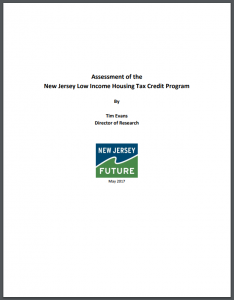Assessment of the New Jersey Low Income Housing Tax Credit Program
New Jersey results contrast with national numbers; could provide example for other states on how to begin reversing the trend of concentrated poverty.
While recent news reports have highlighted the low number of affordable housing projects using federal tax credits that are built in high-opportunity areas, a recent examination by New Jersey Future has found that strategic changes in the way federal funds are allocated for affordable housing in the state have meant that many more affordable housing projects have been directed away from high-poverty neighborhoods and toward areas that offer greater economic opportunity.
To evaluate whether those changes had their intended effect, New Jersey Future compared affordable housing projects that received federal Low Income Housing Tax Credits between 2005 and 2012 with projects that received credits between 2013 and 2015, after the New Jersey Housing and Mortgage Finance Agency (NJHMFA), which administers the tax credits in the state, made significant changes to the criteria it uses to award them. The agency made the changes with the specific goal of steering new construction of affordable housing away from areas of concentrated poverty and toward areas where public transit and major job centers existed, and that have higher-performing school districts.
Before the adjustment, a full two-thirds of projects near transit were located in distressed or low-income places; after the adjustment, 79 percent of such projects were located outside of low-income census tracts. Half of all projects post-2013 were in municipalities with strong job centers, and more than a third were located in higher-performing school districts. (The last two criteria were not tracked prior to 2013, so no comparison data are available.)
By contrast, despite it being an explicit goal of the LIHTC program to create new affordable housing in high-opportunity areas, as few as 17 percent of projects financed with LIHTCs nationally are estimated to have been built in such places. As news reports noted, studies have shown that moving families to high-opportunity areas helps their children rise out of poverty, thus reducing the chance that as adults they will need housing assistance.
According to Anthony Marchetta, executive director of NJHMFA, the Low Income Housing Tax Credit program is widely considered to be the most successful affordable housing production program the state has had. This report highlights New Jersey’s pioneering role in using its allocation criteria to make a significant difference in moving people away from areas of concentrated poverty and into areas of opportunity. The changes NJHMFA made can thus serve as a model for other states interested in similarly directing their allocation of affordable-housing tax credits.
The New Jersey Future report highlights where the NJHMFA program has made strides and which data should continue to be tracked to see if more gains can be made.











